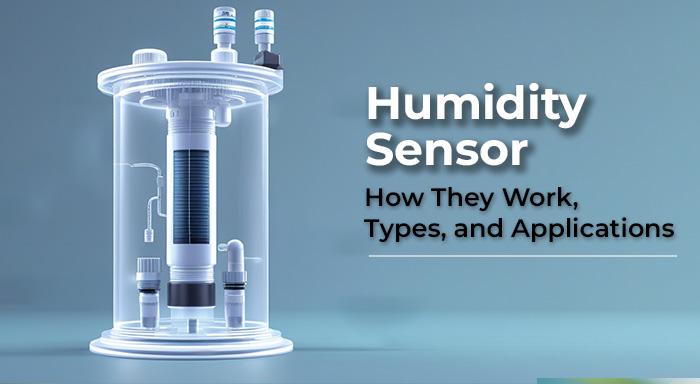
What is IoT?
Before diving into humidity sensors, it’s important to understand the broader concept of IoT. The Internet of Things (IoT) refers to the network of interconnected devices that communicate with each other and exchange data through the internet. This could include anything from smart home devices like thermostats and lights to industrial machines that monitor and adjust conditions in factories. By embedding sensors and software into devices, IoT systems enable automation, remote monitoring, and smarter decision-making.
What is a humidity sensor?
A humidity sensor, often referred to as a hygrometer, is a device that detects and measures the amount of water vapor in the air. The results are typically expressed as relative humidity, which is the percentage of water vapor present compared to the maximum amount the air can hold at a given temperature. These sensors are indispensable in environments where precise humidity control is critical, such as agriculture, HVAC systems, and manufacturing processes.
How Do Humidity Sensors Work?
Humidity sensors function by measuring changes in physical or electrical properties of materials due to moisture content. They generally fall into three main categories:
- Capacitive Sensors: These are the most common type used in IoT applications. A capacitive humidity sensor comprises two electrodes separated by a hygroscopic dielectric material. When moisture levels in the air change, the dielectric constant of the material shifts, altering the capacitance. This change is then converted into a digital signal for further analysis.
- Resistive Sensors: These sensors work by measuring the electrical resistance of a material that varies with humidity. As moisture content increases, the material’s conductivity changes, providing a way to measure relative humidity.
- Thermal Sensors: Also known as psychrometers, these devices measure humidity by comparing the temperature of a dry sensor to that of a wet sensor. The difference in temperature correlates to the moisture content in the air.
Each type of sensor has its advantages and is chosen based on the specific requirements of the application, such as accuracy, response time, and environmental conditions.
Types of Humidity Sensors
Humidity sensors can be classified based on their functionality and output:
- Digital Sensors: These sensors provide precise humidity readings in digital format, making them ideal for integration with IoT systems.
- Analog Sensors: These generate an analog voltage output proportional to the humidity level and require additional processing for IoT compatibility.
- Temperature and Humidity Sensors: Many modern sensors combine temperature and humidity measurement in a single device, streamlining data collection and analysis for IoT applications.
Applications of Humidity Sensors in IoT
The integration of humidity sensors with IoT has unlocked a plethora of applications across various industries:
- Agriculture: Monitoring soil moisture and atmospheric humidity helps optimize irrigation schedules, ensuring better crop yields and water conservation.
- HVAC Systems: IoT-enabled humidity sensors regulate indoor climate control systems, improving energy efficiency and comfort.
- Healthcare: Maintaining specific humidity levels in hospitals and laboratories is crucial for patient care and preserving medical equipment.
- Smart Homes: In smart homes, IoT sensors track indoor humidity levels, triggering actions such as dehumidifier operation or alerting homeowners about potential mold risks.
- Industrial Applications: Manufacturing processes like semiconductor production or textile drying require precise humidity control to maintain product quality.
- Weather Monitoring: IoT sensors in weather stations provide real-time data on humidity, aiding in accurate forecasting and climate research.
The Role of IoT in Enhancing Humidity Sensors
IoT revolutionizes how humidity sensors are utilized by connecting them to networks that enable real-time data monitoring, analysis, and decision-making. Here’s how IoT enhances their functionality:
- Remote Monitoring: IoT-enabled sensors transmit data to cloud platforms, allowing users to monitor conditions from anywhere.
- Automation: Combined with other IoT devices, humidity sensors can trigger automated responses like adjusting irrigation systems or HVAC settings.
- Predictive Maintenance: IoT systems analyze historical data from sensors to predict potential issues, reducing downtime and maintenance costs.
- Data Integration: IoT platforms integrate data from multiple sensors, providing comprehensive insights into environmental conditions.
Conclusion
Humidity sensors are indispensable tools in various industries, and their integration with IoT has amplified their utility. By enabling remote monitoring, automation, and real-time data analysis, IoT sensors make environments smarter and more efficient. Whether in agriculture, healthcare, or smart homes, understanding how these devices work and their applications is crucial for leveraging their potential. As IoT continues to evolve, the role of humidity sensors will only expand, driving innovations and improving quality of life.
Related Posts:
What are IoT architecture and protocols?
What are the 7 Layers of the IoT Architecture Reference Model?
Understanding the Building Blocks of IoT Architecture